
AOCC – Day One
After all the teams collected their hardware 36 hours before, everyone had had plenty of time to get accustomed to their new parts and make any necessary volt and motherboard modifications. It was time to find out who had the skills (and luck of the draw) to claim the AOCC 2008 crown.The first concern of the day as the overclockers began to setup was the level of humidity inside the shopping centre in which the event was being held. Due to recent Hong Kong legislation it could no longer keep the air conditioning at “arctic.” The extra humidity in the air would only add to the problem of condensation, and some were concerned about the potential build up of ice on their setups.
Upon arrival, teams setup and were handed the first canisters of LN2 from the huge tanks Asus had provided for the event. The teams went on to make use of an incredible 1,600 litres of the very very cold stuff throughout the event, with some teams keeping their equipment at sub -100°C for over eight hours on the first day! Most teams then proceeded to find the limits of their hardware, finding the highest possible multiplier, front side bus and voltages that their chips could handle before trying to tie it all together in fully fledged overclocks.
It wasn’t long before some the problems caused by the processor lottery reared their heads, with China’s processor happily running stable at 5.8GHz, and Portugal hitting a cold bug at just -70°C. The rules of the competition allowed teams to replace their processor once, and several teams chose to do so in the hope of a one more capable of challenging for top honours. For the most part everyone began hitting the performance wall at around 5.4-5.5GHz.
The first test of the day was Super PI 8 million, a single threaded timed test to calculate PI to eight million digits which provides a solid test of CPU and RAM stability and clock speed. For this test, teams used air cooled GTX 280 TOPs rather than their LN2 graphics setups, partly to save on LN2 and mostly to reduce the amount of pouring required (Super PI places no load on the GPU).
Sadly Team GB were unable to challenge in this event, with a CPU that couldn’t clock above 5.4GHz and some system stability problems that prevented them from completing as many successful runs as they would have liked. China and Sweden soon entered into a competition for top spot that would last all day, placing first and second respectively, with France placed a worthy third. However, while super PI was a single threaded CPU only test, the next would bring the GPU into play; 3Dmark 2001
However, this isn’t the 3DMark you might remember from eight years ago, but an enormously tweaked and stripped down version. While the core tests are still there, overclockers force the graphics detail to minimum in the driver software (a feature since removed in 3DMARK software). This means detail drops to that of a game over 10 years old, resulting in frame rates registering in the thousands! The results of 3DMarks 2001 are even altered by the order in which the individual benchmarks are performed in!
This test pushes single threaded 3D performance, so there was a great deal of graphics tweaking involved to achieve the higher scores. Unlike the processors, the Asus GTX 280 TOPs provided for the event were enormously similar in performance, although a few teams were able to hit a core of 1100MHz, resulting in some pretty impressive scores. The GB team managed to overcome their earlier stability issues to place a very respectable ninth, and securing a few points, while China again placed first with Sweden and Portugal snapping at their heels.
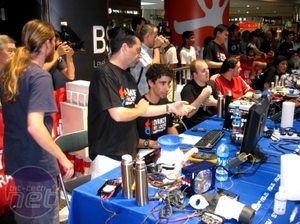
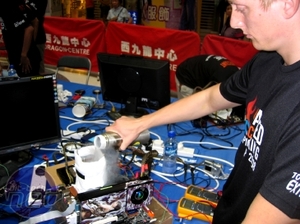
Click to enlarge - Team Portugal discuss their poor first processor, while Team Sweden poor their way to second place
The final test of the day was the most modern, with 3DMark vantage, which utilises multiple cores, DirectX 10 and PhysX to produce a rounded benchmark result. As any up-to-date bit-tech reader will know, the GT200 series of cards have PhysX support included, so I had expected some interesting compromises between GPU and PhysX processing from the contestants. However, the overclocking scene firmly believes in a level playfield between different manufacturer’s hardware, so until both ATI and Nvidia support GPU based PhysX, only non PhysX Forceware drivers are allowed.
Because the final test was Vista based, we did see a great deal of operating system tweaks in place to squeeze the last drops of performance from the systems, which in some cases had been sub zero for hours and had collected some worrying levels of ice on CPU pots. The competition was fierce in this final benchmark, with Sweden needing a win and for China to place third or lower to secure victory.
Sadly the British team suffered a terminal graphics failure as condensation shorted out their card, and dumped them out of the last section of the competition without a score. Other teams fared much better, but were uniformly restricted by the time limit involved and the length of the benchmark itself to run. The last ten minutes were decisive as China eclipsed Sweden’s score by a whopping 500 marks, and then Portugal piping Sweden to second place, giving China an undisputed victory in all three events.

MSI MPG Velox 100R Chassis Review
October 14 2021 | 15:04

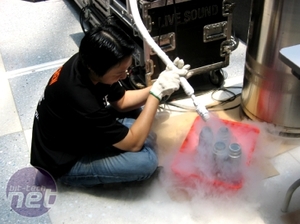

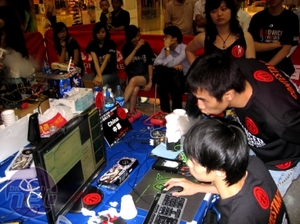
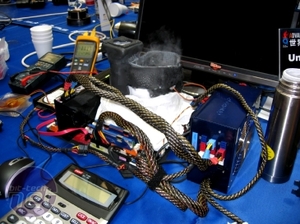







Want to comment? Please log in.